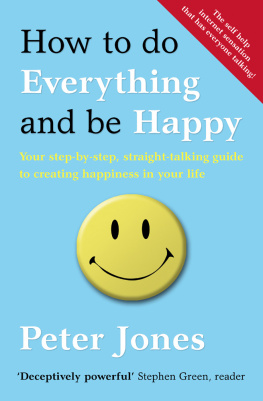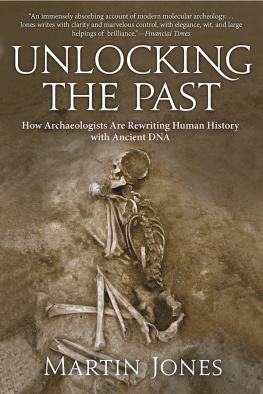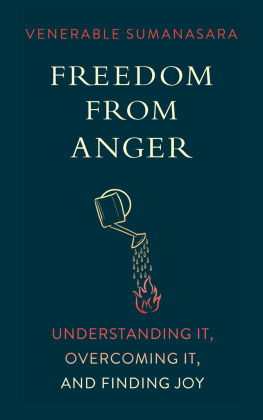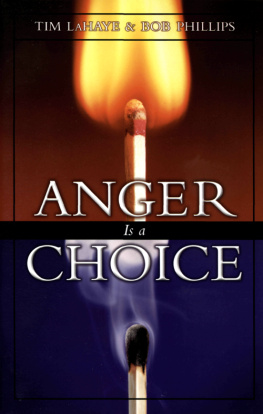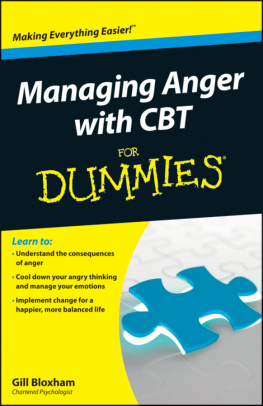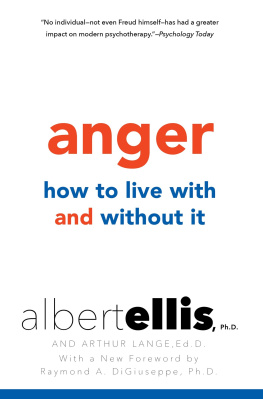OVERCOMING
ANGER
How to
Identify It,
Stop It,
and
Live a
Healthier
Life
By Carol D. Jones, Ph.D., M.F.T.

ADAMS MEDIA
Avon, Massachusetts
Copyright 2004 by Carol D. Jones.
All rights reserved. This book, or parts thereof, may not be reproduced in any form without permission from the publisher; exceptions are made for brief excerpts used in published reviews.
Published by
Adams Media, an imprint of Simon & Schuster, Inc.
57 Littlefield Street, Avon, MA 02322. U.S.A.
www.adamsmedia.com
ISBN 10: 1-58062-929-6
ISBN 13: 978-1-58062-929-4
eISBN: 978-1-44051-918-5
Printed in the United States of America.
J I H G F
Library of Congress Cataloging-in-Publication Data
Jones, Carol D.
Overcoming anger / Carol D. Jones.
p. cm.
Includes bibliographical references.
ISBN 1-58062-929-6
1. Anger. I. Title.
BF575.A5J66 2004
152.4'7--dc21
2003008261
This publication is designed to provide accurate and authoritative information with regard to the subject matter covered. It is sold with the understanding that the publisher is not engaged in rendering legal, accounting, or other professional advice. If legal advice or other expert assistance is required, the services of a competent professional person should be sought.
From a Declaration of Principles jointly adopted by a Committee of the American Bar Association and a Committee of Publishers and Associations
This book is available at quantity discounts for bulk purchases.
For information, call 1-800-289-0963.
Dedication
This book is dedicated to Steve, who always cleans up after Im through.
Acknowledgments
This book is the result of gifts given me by my many excellent teachers and friends and my happy association with the United States Marine Corps. But above all it is the result of my clientswonderful, brave people who have shared their worlds with me and taught me what being human is all about.
Table of
Contents
Introduction
A n ice carvers artistry lies in her ability to envision something exquisite within the bulky parameters of a mundane block of ice and to know which tools will work best to achieve her goals. Similarly, a therapist working with people in trouble because of their anger, or because of domestic violence, or because of other pain-filled relationships, is faced with closed-down entities, brittle yet vulnerable. The therapist must consider and weigh, and at the same time chip away at, a system thats not working very well. The therapist has to whittle away at the structure of the clients anger system and the pain enclosed within.
In working with confused, unhappy individuals, couples, and families, I have gained new insight into anger, its sources and consequences, and Ive had the opportunity to explore my ideas in my consulting practice and in teaching classes and workshops aimed at general audiences. What I have discovered has not only been of help to others but has allowed me to look at anger in new ways. This in turn has helped me discover that my ideas do not apply simply to anger and violence but also to all the other unhealthy stuff that anger brings with it.
When I asked clients who were initially angry, sometimes frightened (and sometimes frightening!), to describe what they were so mad about, they began to reveal new aspects of themselves. Rather than being the powerful, vengeful, in-control creatures they at first appeared to be, they began to reveal themselves to be actually pretty miserable people who felt out of control of their private universes.
Rather than being merely angry (the Funk & Wagnall definition of anger is a feeling of sudden and strong displeasure and antagonism directed against the cause of an assumed wrong or injury), they were enraged, not at one specific thing, but at everything at the same time. They described emotions that were overwhelming to them. It was almost as if they were trying to describe something out of Conrads Heart of Darkness, where Kurtz exclaims the anguish in his soul: The horror! The horror!
How awful! How scary! How confusing! And, ultimately, how very sad for those who experience such anger.
After I had noted this difference between everyday garden-variety anger (the kind you get when someone cuts you off in traffic) and the almost mythic angst my clients were describing, it seemed important to look at this rage from different angles and determine how my clients came to feel so terribly powerless in its grip. In truth, when they allowed themselves to think about the way anger was ruling and ruining their lives, these folks felt awful about not only their behavior, but also about their feelings of helplessness.
To put it simply, they were scared! They viewed their rage as a self-perpetuating, continuous, all-powerful, and consequently hopeless condition. Over and over clients said that they felt stuck, that even the most insignificant things could feel so threatening that it was impossible to communicate their feelings. Many had almost given up and no wonder! For some, this sense of threat and futility spilled over into all areas of their lives, and the result was even more frustration.
So, the question is, Were the intense feelings they were experiencing really feelings of anger, or were they something else? If they were something else, diagnosing them as having a problem controlling their anger and using typical anger management techniques (like time-outs) wouldnt really solve anything. In fact, it could easily add to their frustration level and ultimately make things worse.
While many books on anger touch on the idea of explaining whats beneath the anger response, most put forth anger management precepts in an almost confrontational fashion, from a didactic, or teacherly, power position. The common message has been, What youre doing is wrong. Heres why. Now just shape up, or else.
In this book, I take a different approach. I help those who suffer from anger, or friends and loved ones of those who suffer from anger, to unravel their web of angst and seek positive solutions to their problem.
By looking at anger issues from a different angle, we can be kinder to ourselves and thus become better able to give ourselves reality checks without being defensive. When we are better able to explore our reactions without hostility and wariness, improved communication will result.
My hope is that, in evaluating the covered-up, subterranean emotions, you will gain the ability to choose how to react and develop improved problem-solving abilities that lead to safer, more productive solutions to anger. In this book, I will take a close look at anger, confrontation and conflict resolution, stress management, communication and assertion, and offer suggestions and exercises to help approach these problems in a positive, productive way.
Youll develop new skills that will enrich your life, and youll gain the confidence to take charge and overcome your anger.
1
Angers Terrain
Keeping the Wolves
at Bay
L ets face itif we didnt need anger, we probably wouldnt have evolved with it. Anger in itself is neither positive nor negative as an emotionit is what you make it. It serves a function, though, and so it remains. Anger is very effective in accomplishing certain things. For instance, it helps us stay alive. Anger wakes us up. It arouses and gets us ready to take action. In the words of Mr. Spock from the TV series Star Trek, Jim, madness has no purpose, no reason, but it may have a goal (circa 1965).
Other species have instincts, those special little behavioral gizmos built right in that help them protect their interests when they are threatened. For example, big brown bears stand on their hind legs and bellow, tigers flatten their ears while exposing awesome choppers, bulls paw the ground, nostrils flaring, and even the wimpiest of dogs can snarl and yap like the dickens. In their own ways, these animals are trying to let you know they are a force to be reckoned with. They dont want to be messed with anymore. They look mad, growling and grimacing, but are they
Next page


